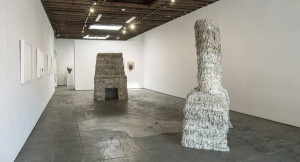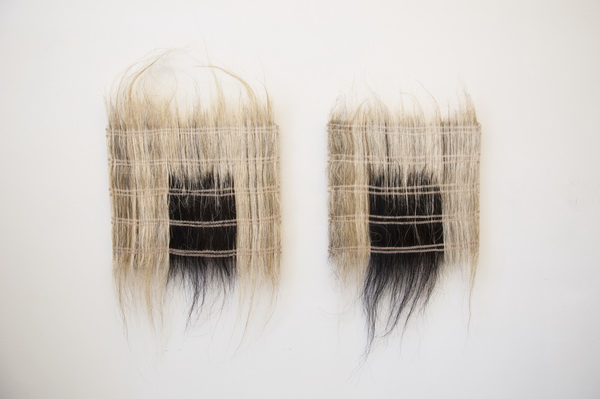Vestiges of the past can be found all over the West; dead and dying towns are replete with inklings of historic spirit in the forms of half-buried artifacts, wild animals and deserted buildings. Entering Catherine Fairbanks’ exhibition,” Two Chimneys” evoked the initial sensation of stepping into ruins of the Old West. That feeling quickly gave way to the realization that these artful ruins were conspicuously simulative; and as such, they stood not so much for the past, but for the ways that conceptions mutate, deteriorate and are preserved over time.
Themes of imitation permeate Fairbanks’ use of materials. From afar, the show’s titular centerpieces, Chimney Sculpture 1 (2015–16) and Chimney Sculpture 2 (2016) appeared to have been constructed of mud bricks or ceramics; closer, it was clear that they were made of neither. Fashioned from a papier-mâché mixture of wheat paste and shredded newspaper, these pieces recall Peter Voulkos’ ceramic chimney sculptures. Fairbanks is also a ceramicist, yet she applies ceramic techniques and principles to materials other than clay.

Installation view of Two Chimneys by Catherine Fairbanks at Wilding Cran Gallery. Courtesy of Wilding Cran Gallery.
In a series of embossed drawings created from wet papier-mâché placed behind sheets of paper and allowed to dry, without using any clay, Fairbanks employs ceramics’ core principle—expansion and compression due to water content and loss. Yet the drawings’ surfaces, which loosely depict mythological figures, look remarkably like cracked clay on desert ground. Like mud, myths and memories are slippery: they also crack and crumble as they age.
Fairbanks formed her chimney sculptures from coils of a special blend of papier mâché that is moldable like clay before induration. The life-size ersatz smokestacks seem at once sturdy and fragile, strong and decrepit. Lone chimneys, the last remnants of pioneer houses, can be seen throughout the Midwest and the West. As the last structures standing, they are icons of fortitude; yet they also serve as reminders of what is gone, marking the absence of what has been destroyed by elemental deterioration. Fairbanks’ rickety versions of the stalwart symbols invoke this paradox.
Newspapers are current for only one day; ephemerality is further connoted by the periodical shreds that drip and dangle from the sculptures’ hand-built masses like rats’ or birds’ motley nests. We think of man-made buildings as everlasting, but are they really so much different from other animals’ shelters in their vulnerability to environmental vicissitudes?
Hung side-by-side on a nearby wall, Luce’s Fireplace 10 (2014) and Luce’s Fireplace 12 (2014) two-dimensionally echoed the chimney hearths. In contrast to the ramshackle sculptures, these small mats of bound horsehair looked like well-preserved mementos. During a residency, Fairbanks acquired the horsehair from an Icelandic butcher. Horses were once revered as legendary symbols by people of Iceland, just as our wild horses were, until recently, revered. Today, equines are slaughtered in Iceland for food and in America because our government considers them a menace.
Today’s relic is tomorrow’s discard. Fairbanks’ unassumingly forceful explorations of materials, myths and monuments suggest that things are not always as they seem, that bygone days and historic objects may have been quite different from the way they are currently remembered and preserved.



















0 Comments